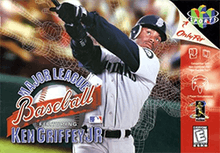Major League Baseball Featuring Ken Griffey, Jr.
| Major League Baseball Featuring Ken Griffey, Jr. | |
|---|---|
 North American Nintendo 64 cover art | |
| Developer(s) | Angel Studios |
| Publisher(s) | Nintendo |
| Platform(s) | Nintendo 64 |
| Release date(s) |
|
| Genre(s) | Sports |
Major League Baseball Featuring Ken Griffey, Jr. is an arcade-style baseball video game produced by Nintendo and developed by Angel Studios for the Nintendo 64 platform. The game is follow-up to Nintendo's previous title featuring Griffey, Ken Griffey, Jr.'s Winning Run. It was released on May 31, 1998, and allows players to choose any contemporary Major League Baseball franchise and play through an exhibition, a complete season, or a World Series. Players can also choose any player from any team to compete in a Home Run Derby. The player can also select up to four individuals to play as in Home Run Derby. The game also featured all 30 MLB team's stadiums. The game was seen as a faster, more arcade-like baseball game compared to its rivaling product, the more realistic baseball simulation All-Star Baseball '99. Nintendo released a sequel the following year, called Ken Griffey, Jr.'s Slugfest.
Gameplay
Batters and fielders abilities are measured with five different statistics: Batting, Power, Speed, Defense, and Arm. Pitchers abilities are measured with three different statistics: Speed, Stamina, and Control. Statistics are measured by a number 1-10, with 1 being the weakest and 10 being the best.
Every pitcher in the game has four pitches. The first pitch, which is used by pressing the A button, is always a fastball. The second pitch, a breaking ball, is thrown by pressing the B button. Pitches thrown with the B button include curveballs, sliders, and screwballs. The third pitch is the changeup, and is used by pressing the Z button and the A button simultaneously. The fourth and final pitch is the "special." Special pitches include the super fastball, super changeup, splitter, cut fastball, and knuckleball. The special pitch is used by pressing the Z and B buttons at the same time.
Batters use the analog stick to move a batting circle to where the pitch is shown to go before it reaches the plate. The batter then presses A to swing. If the batting circle is placed where the ball is thrown, and the swing is on time to when the pitch goes over the plate, the ball will be hit.
Baserunning on offense and throwing to bases on defense is controlled by the C buttons. The button pressed corresponds to the base (Ex. The right C button is pressed to go to 1st base, up to go to 2nd base, etc.).
The game accounts for injuries and real time fatigue, seen most clearly through pitchers. This is especially true if the pitcher uses their "special" pitch too often.
Features
- Official MLBPA licensing; more than 700 official players
- Season stat tracking; team, players, schedules, injuries, scoring.
- Three skill levels, two different batting styles (arcade and classic), alternate running styles
- Dynamic camera angles
- Multiple gameplay modes, including exhibition, season, world series and home run derby
- EEPROM data management
- Commentary by Ken Griffey
- Rumble Pak compatible
- Two-players simultaneous; four-player home run derby mode
Another feature in this game is the audio which Griffey personally composed. On it he played drums, keys, guitar, and funk bass. Griffey was said to be upset with the last few games soundtrack and felt that the bass just wasn't funky enough to do a good selling job.
Reception
The game was rated 7.7/10 by IGN[1] and 6.8/10 by GameSpot.[2]
Despite the average ratings from critics, the game had a large fanbase.
See also
References
- ↑ "Major League Baseball Featuring Ken Griffey Jr". IGN. IGN Enterianment. June 2, 1998. Retrieved March 16, 2012.
- ↑ Mac Donald, Ryan (June 11, 1998). "Major League Baseball Featuring Ken Griffey, Jr. Review". GameSpot. CBS Interactive. Retrieved March 16, 2012.
Ken Griffey with Sonics jersey and scar==External links==